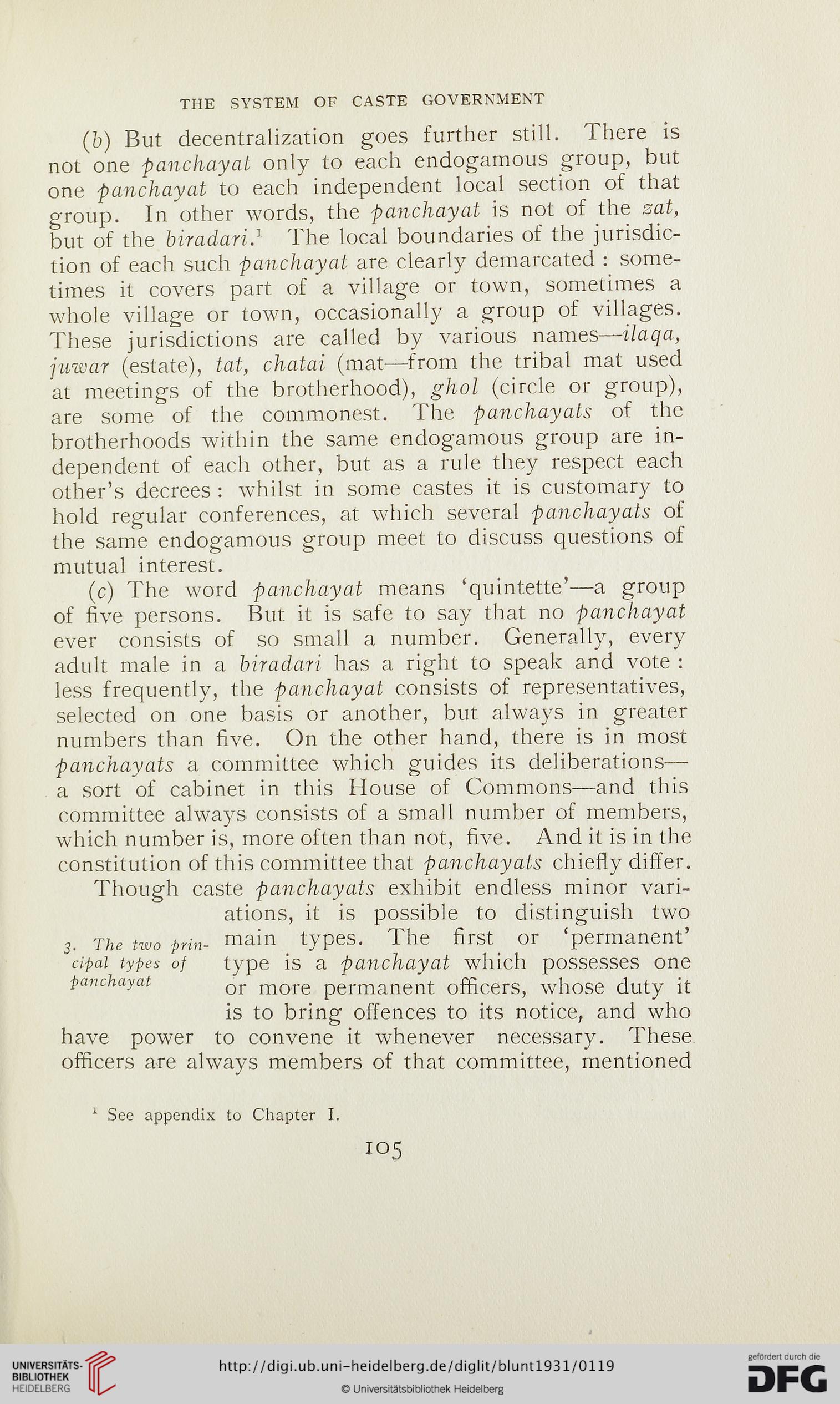THE SYSTEM OF CASTE GOVERNMENT
(b) But decentralization goes further still. There is
not one panchayat only to each endogamous group, but
one fanchayat to each independent local section of that
group. In other words, the panchayat is not of the zat,
but of the biradari.1 The local boundaries of the jurisdic-
tion of each such panchayat are clearly demarcated : some-
times it covers part of a village or town, sometimes a
whole village or town, occasionally a group of villages.
These jurisdictions are called by various names—ilaqa,
juwar (estate), tat, chatai (mat—from the tribal mat used
at meetings of the brotherhood), ghol (circle or group),
are some of the commonest. The panchayats of the
brotherhoods within the same endogamous group are in-
dependent of each other, but as a rule they respect each
other’s decrees : whilst in some castes it is c.ustomary to
hold regular conferences, at which several panchayats of
the same endogamous group meet to discuss questions of
mutual interest.
(c) The word panchayat means ‘quintette’—a group
of five persons. But it is safe to say that no panchayat
ever consists of so small a number. Generally, every
adult male in a biradari has a right to speak and vote :
less frequently, the panchayat consists of representatives,
selected on one basis or another, but always in greater
numbers than five. On the other hand, there is in most
panchayats a committee which guides its deliberations—
a sort of cabinet in this House of Commons—and this
committee always consists of a small number of members,
which number is, more often than not, five. And it is in the
constitution of this committee that panchayats chiefly differ.
Though caste panchayats exhibit endless minor vari-
ations, it is possible to distinguish two
3. The two prin- main types. The first or ‘permanent’
dpai types of type is a panchayat which possesses one
panchayat Qr more permanent officers, whose duty it
is to bring offences to its notice, and who
have power to convene it whenever necessary. These
officers are ahvays members of that committee, mentioned
1 See appendix to Chapter I.
(b) But decentralization goes further still. There is
not one panchayat only to each endogamous group, but
one fanchayat to each independent local section of that
group. In other words, the panchayat is not of the zat,
but of the biradari.1 The local boundaries of the jurisdic-
tion of each such panchayat are clearly demarcated : some-
times it covers part of a village or town, sometimes a
whole village or town, occasionally a group of villages.
These jurisdictions are called by various names—ilaqa,
juwar (estate), tat, chatai (mat—from the tribal mat used
at meetings of the brotherhood), ghol (circle or group),
are some of the commonest. The panchayats of the
brotherhoods within the same endogamous group are in-
dependent of each other, but as a rule they respect each
other’s decrees : whilst in some castes it is c.ustomary to
hold regular conferences, at which several panchayats of
the same endogamous group meet to discuss questions of
mutual interest.
(c) The word panchayat means ‘quintette’—a group
of five persons. But it is safe to say that no panchayat
ever consists of so small a number. Generally, every
adult male in a biradari has a right to speak and vote :
less frequently, the panchayat consists of representatives,
selected on one basis or another, but always in greater
numbers than five. On the other hand, there is in most
panchayats a committee which guides its deliberations—
a sort of cabinet in this House of Commons—and this
committee always consists of a small number of members,
which number is, more often than not, five. And it is in the
constitution of this committee that panchayats chiefly differ.
Though caste panchayats exhibit endless minor vari-
ations, it is possible to distinguish two
3. The two prin- main types. The first or ‘permanent’
dpai types of type is a panchayat which possesses one
panchayat Qr more permanent officers, whose duty it
is to bring offences to its notice, and who
have power to convene it whenever necessary. These
officers are ahvays members of that committee, mentioned
1 See appendix to Chapter I.




